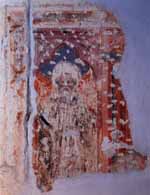
Antonio Veneziano (?), St Anthony the Abbott, Zadar, St Simeon's church.
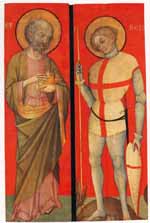
Menegelo Ivanov de Canali, St
Mathew and St Georg, Tryptych "Varoške Gospe", Zadar, Permanent Exhibition
of Sacral Art.
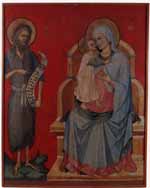
Menegelo Ivanov de Canali, Mother
of Christ with Child and St John the Baptist, Kraj on the isle of Pašman,
Treasure of the St Dujo's monastery.
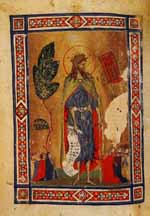
Menegelo Ivanov de Canali (?),
St John the Baptist, Matrikula Bratovštine 'Gospe od Umiljenja i Sv. Ivana',
Zadar, Scientific library.
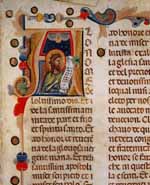
Menegelo Ivanov de Canali (?),
Inicijal "A" with figure of St John the Baptist, Matrikula Bratovštine 'Gospe
od Umiljenja i Sv. Ivana', Zadar, Scientific library.

Ivan Petrov iz Milana, Fragment
of the polyptych from Luka on the isle of Dugi otok, Zadar, Permanent Exhibition
of Sacral Art.
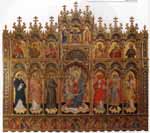
Ivan Petrov iz Milana, "Ugljan
Polyptych" from St Jerome's monastery on the isle of Ugljan, Zadar, Franciscan
monastery.
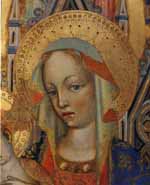
Ivan Petrov iz Milana, "Ugljan
Polyptych" (detail).
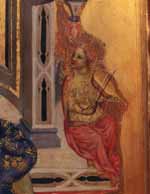
Ivan Petrov iz Milana, "Ugljan
Polyptych" (detail).
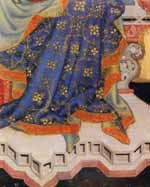
Ivan Petrov iz Milana, "Ugljan
Polyptych" (detail).
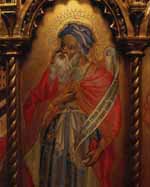
Ivan Petrov iz Milana, "Ugljan
Polyptych" (detail).
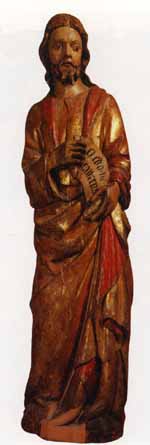
Matej Moronzon and Ivan Petrov
from Milan, St James the Less, Zadar, Permanent Exhibition of Sacral Art in
Zadar.
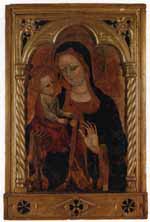
Dujam Vučković (?), Mother of
Christ with Child from Rava, Zadar, Permanent Exhibition of Sacral Art.
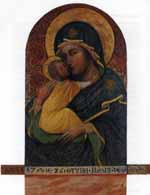
Blaž Jurjev, "Gospa od Zdravlja",
Zadar, Permanent Exhibition of Sacral Art.

Andrea Mantegna (?), Mother of
Christ with Child, Pag, Benedictine monastery.
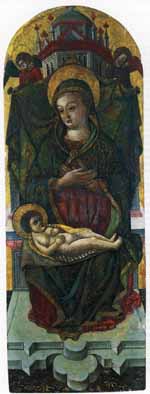
Petar Jordanić, Mother of Christ
with Child, Tkon, Parish church.
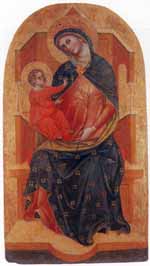
Paolo Veneziano, "Gospa Maslinska",
Zadar, Permanent Exhibition of Sacral Art.
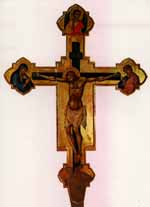
Catarino, Crucifix, Zadar, Permanent
Exhibition of Sacral Art.
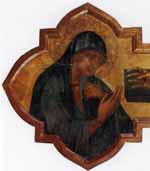
Catarino, Crucifix (detail), Zadar,
Permanent Exhibition of Sacral Art.
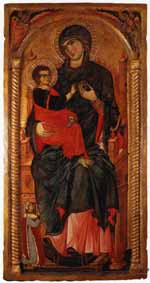
"Bogorodica benediktinki", Zadar,
Permanent Exhibition of Sacral Art.
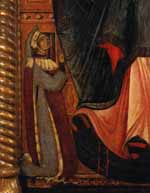
"Bogorodica benediktinki" (detail),
Zadar, Permanent Exhibition of Sacral Art.
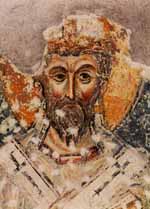
St Donat, Zadar, Cathedral.
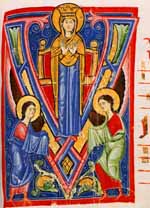
Illumination in the antiphonal,
Zadar, Franciscan monastery.
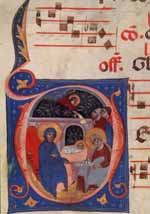
Illumination in the gradual "A",
Zadar, Franciscan monastery.
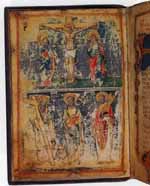
Miniatures in the matricula of
St Andrew's brotherhood of sailors and fishermen, Zadar, Scientific library.
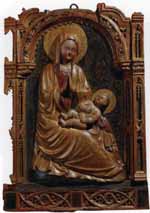
Mother of Christ with Child, Zadar,
Permanent Exhibition of Sacral Art.
EMIL HILJE: GOTHIC PAINTING IN ZADAR
(summary)
Unlike earlier periods of the Middle
Ages from which, apart from a few concrete pieces of art, practically no other
information have come down to us to help us today in our comprehension of
visual art and culture in Zadar of those days, the age of Gothic was the time
of intense and continually growing need for notary offices in the city, which
is an undisputable evidence that written word was more and more frequently
used in everyday communication between its citizens. In the line of such progress,
certain facts and events related to artistic activities in the area were recorded
in writing, thus providing the grounds for later definition of the importance,
role and chronological place of individual artists. What is even more important,
these archival records have undoubtedly marked Zadar as the milieu which,
although not really "producing" the greatest artists of those days, had established
itself as the environment which was not visited by the truly great names just
temporarily, on their way to other destinations, but as the place they often
chose as their permanent residence. This is how Zadar became the source from
which Gothic culture (and painting in particular) emanated and spread to other
Dalmatian communities.
A number of surviving records mention the
painters whose works got lost over the centuries, but who certainly did work
in Zadar through the 14th and 15th centuries. One of them is Ivan Klerikopulus
who, in the year 1314 put his signature on the painting that was once in the
church of St. Demetrius. Records dating from the middle of the 14th century
mention a painter named Benedikt, his two sons Martin and Krešo and Krešo's
son Damjan (Domol). Yet, there is no written trace of any of their artistic
activity. In 1348, Mišul Pavlov Selipetar, a Zadar resident, accepted the
order to paint in Dubrovnik a canvas depicting several saintly figures, but
in his home-town archives he is mentioned only once, in the year 1350. The
painters Lav, Pavao from Siena, Anđeo Franjin from Ancona, Antun Lovrin from
Split and Bartul (Bratan) from Trogir are mentioned in the Zadar archival
holdings originating from the late 14th century, but, again, there are no
records of their artistic performance. Ivan Tomazinov from Padua lived and
worked in Zadar from 1384 to 1386, and three of his contracts have been preserved:
one of them is related to his commitment to paint a picture for the church
of St. Demetrius, the second obliged him to produce a polyptych for the church
of St. Michael in Trnovo and under the third contract he was to make a polyptych
for the church of St. Mary of the Priests. Stjepan Martinov Lazanja took upon
himself to make a polyptych like the one formerly made by Ivan Tomazinov for
the church of St. Michael in Trnovo. Another painter named Blaž, son of Luka
Banić, the pupil of Jacobello di Bonomo, was active in Zadar between the years
1386 and 1411. Archival records tell us that he did the wall-paintings (frescoes)
decorating the chapel in the house of the wealthy merchant Nikola Mihovilov
and that he also made the altar retable for the church of St. Nicholas. The
Zadar archives also keep records of some other painters who worked in Zadar
during the first half of the 15th century, but of whose artistic achievements
we unfortunately have no surviving examples. These are: Dominik Ivanov Falkon
from Naples, Toma Mavrov Grisogono, Marko Nikolin from Dubrovnik, Juraj Kandijev,
Mojsije Jakovljev, Marin from Split, Jakov, Jakov Vučinov, Franjo Malano,
Milko Banić, Martin, Dominik Andrijin, Marko Menegelov and Jakov de Taranto.
Very scanty are also the informations about the visitation to Zadar of the
Venetian painter Donato Bragadin who, together with his sons Jakov and Toma,
worked on the decoration of the chapel of St. Anastasia in the Zadar Cathedral
round the middle of the 15th century. Donato's third son Petar Bragadin pledged
himself on October 7th 1460 to decorate with gold plating and blue paint the
newly erected chapel in the monastery of St. Demetrius. Unfortunately, no
trace of the mentioned works or of any other artistic performance by the members
of the Bragadin family in Zadar has survived. Records dating from the second
half of the 15th century mention the names of Nikola Ivanov from Venice, Marin
Vučković, Petar from Koper, Franjo from Verona and the Venetian wood-engraver
Jakov Moronzon (who was a painter, too). Again, there is no evidence of their
artistic work.
Nikola Ciprijanov de Blondis, a painter from Zadar, worked in Venice during
the period between the years 1351 and 1374. For five years he was a pupil
of Paolo Veneziano and in 1366 he was granted Venetian citizenship. While
visiting Zadar, on March 1st 1376, he made a written promise to the citizens
of Nin, Ivan Boršin and Grgur Dobrošev, to make for them two crucifixes of
the same shape, size and quality as the one that he had sold to the Zadar
Franciscans, not long before that. The agreed price was two hundred and seven
and a half gold florins. Regretfully, none of these crucifixes have survived.
Even in the Venetian painting heritage there are no works which could be with
certainty ascribed to master Nikola Ciprijanov. Only recently, a small painting
representing the Dead Christ, garnered in the Kynžvart Castle in the Czech
Republic, was attributed to him. It is a minor artistic achievement, yet it
reveals all the features typical of the painters grouped around Paolo Veneziano.
The remaining frescoes in the church of St. Simeon which, according to the
records, presumably originate from the eighties of the 14th century, are today
in a pretty bad condition. Only one part has, to a certain extent, survived
till our time. It represents the figure of St. Anthony the Abbott. This fragment,
however small, discloses remarkable artistic skill and refinement. On the
grounds of the archival data indicating that Antun, a painter from Venice,
stayed in Zadar in 1388 and on the grounds of certain resemblance with the
style of the paintings by the famous Antonio Veneziano who produced most of
his opus in the seventies and eighties of the 14th century, it is believed
that the frescoes in the church of St. Simon were made by no one else but
Antonio Veneziano.
Available information on Menegelo Ivanov de Canali from Venice, who spent
forty years working in Zadar, are by far the most extensive information about
any of the painters mentioned in the Zadar archival holdings. There are some
hundred documents with his name in them, all dating from the period between
1385 and 1427. Many of them are records of his artistic work. On August 14th
1385 he signed a contract with a wood-carver named Marko Nikolin, under which
he was obliged to make an altarpiece at the price of 13 ducats. Another document
dated October 3rd 1386 states that he drew the plan for the construction of
the tombstone for the archbishop Nikola Matafar. The construction work was
assigned to the sculptor Pavao from Sulmona. On October 4th 1387 Menegelo
Ivanov agreed with the merchant Nikola Mihovilov to cover with paintings the
polyptych formerly woodcarved by Martin Hermanov. On December 29th of the
same year he signed a contract with the executors of the testament drawn up
by a certain Lucija Petrica. By that contract he was to decorate two altar
retables, one for the main altar in the church of St. Salvation and the other
for the altar of St. John in the church of St. Chrysogonus. In the same year
he painted two more altar retables, for the church of St. Dominic and for
the church of St. Francis, respectively. The contract dated April 18th 1395,
which he concluded with the nobleman Damjan Nassis, entrusted him with the
task of painting the altar retable with the figure of the Mother of Christ,
and on February 22nd 1395 he made a written promise to the nobleman Juraj
Zadulin to decorate the altar retable for the church of St. Mary's Monastery.
His contract with the merchant Nikola Mihovilov signed on February 3rd 1400
states his commitment to produce a retable for the main altar in the church
of St. Chrysogonus, taking as a model the one on the main altar of the Zadar
Cathedral. On September 13th 1403, he took another assignment, this time it
was to the nobleman Gvido Grubonja, for whom he had to do two paintings, at
the price of sixty ducats. On March 27th 1411 he accepted the order to paint
the crucifix for the church of St. Stephan and on January 12th 1413 another
order to paint a canvas for the church of St. Paul in Kukljica. His next job
was to replicate a painting from the Franciscan Church in Split and on November
30th 1418 he bound himself to produce a polyptych for the brotherhood of St.
Jacob. At last, on May 1st 1427, Menegelo put his signature on the crucifix
in the church of St. Lawrence in Kali.
Based on his long and fruitful work in Zadar and on some of the records in
the city archives, it is possible to identify, with quite a large extent of
certainty, Menegelo Ivanov de Canali with the anonymous artist whose opus
was studied and defined by Ivo Petricioli, who named him after the best preserved
piece of art ascribed to him: "Master of the crucifix in Tkon". In the foreign
literature he is usually referred to as "Maestro di S. Elsino". Until now,
his authorship has been confirmed for the following works: the painted crucifix
in the church of SS. Cosma and Damian, on Ćokovac near Tkon, the painting
representing the Mother of Christ with Child and St. John the Baptist, treasured
in the monastery of St. Dujo in Kraj on the isle of Pašman, the tryptych "Varoške
Gospe", displayed at the Permanent Exhibition of Sacral Art in Zadar, the
polyptych in the Picture Gallery in the city of Fermo, a portrayal of the
Mother of Christ with Child placed between two saints, garnered in the New
York Metropolitan Museum, the Mother of Christ with Child in the church of
St. Barbara in Šibenik, the Mother of Christ with Child, exhibited in the
City Museum in Koper and, finally, the Mother of Christ with Child, the angels
and the donors, a painting within a private collection in Florence. Besides
the listed works whose attribution to their author is not questionable, there
are a few others located in the Zadar region, which reveal strong resemblance
with his opus, too. By his stylistic denomination, Menegelo is very close
to the artists of the Venetian school of painting, which was very fruitful
round the end of the 14th century, gathering the artists like: Lorenzo Veneziano,
Nicolò di Pietro, Nicoletto Semitecolo and Giovanni da Bologna. However,
regardless the numerous features shared with those typical of the Venetian
painting, Menegelo's works possess purely individual characteristics and manifest
specific artistic adroitness, especially in the prominent expressiveness of
his colouring, his drawing mastery and the highly sophisticated psychological
characterisation of the portrayed figures. Such quality of his artistic performance
and the important role he undoubtedly played in the Zadar painting environment,
make Menegelo the first clearly distinguished member of what was later to
be called "The Dalmatian School of Painting".
The painter Ivan Petrov from Milan is first mentioned in Dalmatia on January
3rd 1429 when he, together with his companion Dujam Vučković, received ninety
two ducats for painting and gilding the walls of the chapel of St. Dujo in
the Split Cathedral. Some fragments of these frescoes have survived till our
time but, unfortunately, not a single figure has remained fully intact by
deterioration. The name of Ivan Petrov is found in the Zadar archives some
fifty times during the period from 1431 to 1448. On June 16th 1431 he accepted
the order from the Zadar archbishop Lovro Veneir, to paint and gild fifteen
wooden sculptures wood-carved by master Matej Moronzon. His reward for that
job was four hundred ducats. Most of these sculptures (the crucifix and ten
disciples) have been well preserved and are today displayed at the Permanent
Exhibition of Sacral Art in Zadar. On June 10th 1442, following the negotiations
with the representatives of the church of St. Peter in Znojaci, Ivan Petrov
undertook the obligation to produce an altar retable of the same size as had
been the one on the main altar in the church of St. Catherine in Pag. Before
the year 1448 he also did the gilding and painting work in the church of St.
Salvation. The identification problem with Ivan Petrov is very closely connected
with the identification of his companion, Dujam Vučković. Still, the well
documented work of Ivan Petrov on Moronzon's wooden sculptures allows a hypothesis
that he was the master who did the frescoes in Split, too. In the Zadar region,
the following works are ascribed to Ivan Petrov: a fragment of the polyptych
in the small village Luka on the isle of Dugi otok, the Mother of Christ breast-feeding
the Child, treasured in St. Mary's Monastery and the polyptych from St. Jerome's
Monastery on the isle of Ugljan ("Ugljan Polyptych"). All these works affirm
Ivan Petrov as an exceptionally talented and skilful painter of the late Gothic,
whose painting qualities were cultivated in some, not yet quite precisely
defined artistic milieu in Milan, where French and Apenine tendencies and
attitudes to aesthetic perception co-existed. In this respect, his opus may
well be compared to those of Antonio Orsini and Ugolino da Milano, but also
to the Venetian painting school of "International Gothic" (Stefano da Verona,
Michiele Giambon, Giovanni da Francia, Angelo Marino, Jacobello del Fiore).
It was just that genuine amalgam of pragmatical and somewhat rigid northern
painting with the softer, warmer and more lyrical southern forms that gave
Ivan's paintings a distinguished shade of individuality and refinement. Without
any doubt, his "Ugljan Polyptych" remains the finest and the most representative
example of the entire Gothic painting in Croatia.
The name of Ivan's companion Dujam Marinov Vučković from Split also appears
for the first time in the aforementioned document dated January 3rd 1429.
The Zadar archives include some twenty records on his activities between 1422
and 1457. On January 11th 1452 he signed a contract with the representatives
of the Franciscan Monastery, accepting the job of painting and gilding the
wood-engraved retable for the main altar in the church of St. Francis. The
wood-carving was done by Petar de Riboldis. The price stipulated by the contract
was two hundred ducats. However, more frequently than in Zadar, Dujam's name
appears in the Split archives (about thirty times). Some of the contracts
prove that he also did some paintings in Šibenik. Based on his documented
work on Riboldis's altar retable and on his close relationship with Ivan Petrov,
some of the paintings in Zadar have been attributed to him. Among them are:
a portrayal of the Mother of Christ with Child, in the collection of the Franciscan
Monastery, and another painting of the Mother of Christ with Child, from Rava.
Six more works outside Zadar have also been ascribed to him: portrayal of
the crucified Christ with Mary, John the Evangelist and Magdalene, exhibited
in the Art Gallery in Split, the representation of the Mother of Christ with
the Angels in the Abbey Treasury in Korčula, the Mystic Wedding stored in
Hvar, the Mother of Christ breast-feeding the Child, garnered in the monastery
of St. Francis in Šibenik and a fragment of the polyptych from Šibenik, representing
St. Nicholas, which is today part of a private collection in Dubrovnik. All
these works manifest their author's closeness to the Venetian painting tradition
of the second quarter of the 15th century (with the strong influence of Nicolò
di Pietro, Jacobello del Fiore, Michiele Giambon and Pisanello). Not less
evident is the influence of Ivan Petrov from Milan, particularly in his drawing.
Another presumably important man in the formation and development of Dujam's
artistic personality was Blaž Jurjev from Trogir, the most important Dalmatian
painter of that time. In spite of numerous and sometimes divergent influences,
Dujam's painting reveals substantial, true artistic skill and individuality,
primarily accomplished in his characteristic colouring, the resembling physiognomies
and the great attention with which he did the punched and relief ornaments.
The well known Dalmatian painter of the
late Gothic, Blaž Jurjev from Trogir is mentioned in the Zadar archives for
the first time in a document dated March 10th 1445, in connection with his
reward for having painted some beams in the Franciscan Monastery. On October
26th he signed his painting "Gospa od Zdravlja" and on April 28th 1448 he
drew up his testament in which, besides other things, he expressed his last
will to be buried in the church of St. Francis to which he also bequeathed
the entire value of his work on painting one of its altar retables. In the
testament he also exacted that the twelve ducats he had earned for making
the banner for the same church be returned, as well as the nine ducats he
had got for designing and painting the polyptych for the church of Holy Cross
situated outside the city walls. His only surviving work in Zadar, the signed
and dated portrayal "Gospa od Zdravlja" displays some substantial differences
in comparison with the rest of his paintings. They mostly refer to the characteristic
Byzantine compositional and iconographic solutions, which brings us to the
assumption that he must have in fact replicated some highly appreciated painting
from the earlier time.
Among the many Venetian painters who either came directly from the "bottegha"
of Francesco Squarcione or in some other way fell under his influence, there
were three authentic Zadar residents: Carlo Crivelli, mentioned in the records
in the years 1463 and 1465, his brother Vittore, whose name appears in the
documents originating from the period between 1465 and 1476, and Juraj Čulinović,
mentioned in 1461. On the other hand, three paintings preserved in the Zadar
area exhibit typical features of the Squarcione's painting circle, yet none
of them shows substantial resemblance with any of the works produced by the
aforementioned painters. Portrayals of the Mother of Christ with Child and
of the Dead Christ (parts of the former polyptych) in the parish church of
Sali are both minor artistic achievements, yet they reveal certain closeness
with the painting fashion of the Crivelli brothers. However, the Mother of
Christ with Child in the Benedictine Monastery in Pag is a true masterpiece
characterised by supreme adroitness, in certain elements even close to the
paintings of Andrea Mantegna.
The painter Petar Jordanić was a clergyman. His name is found in the records
from 1468 to 1504, but there is not a word about his artistic activity. Yet,
there were two paintings signed with his name: a polyptych in the church of
St. Mary , unfortunately lost in the Second World War and the Mother of Christ
with Child, a painting in private possession in Vienna. Along with these,
the Mother of Christ with Child, in the parish church of Tkon and the fragments
of the painted ceiling of the Zadar Cathedral have also been attributed to
master Jordanić. His painting discloses the substantial importance of three,
rather diverse influences in the formation of his individual artistic features:
the works of Carlo Crivelli, the late Byzantine Italo-Greek school of painting
and the late Gothic painting in Zadar. In these terms, Petar Jordanić appears
to have been quite a unique master, independent of the contemporary artistic
flows. At the same time, he was deeply rooted in the tradition of his own
environment. His opus reveals all the contradictions of heterogeneous sources
he had used, as well as his rather mediocre crafty skill. Yet, in their totality,
all these qualities represent a specific, possibly a little nostalgic recapitulation
of the Gothic painting in Zadar.
Besides native painters, an important segment of the Zadar Gothic painting
comprised the works ordered from Venetian masters. Only a few of them have
survived. The Mother of Christ with Child from the church of Gospa Maslinska
was painted by Paolo Veneziano. A big painted crucifix originating from the
monastery of St. Dominic is attributed to master Catarino. The well known
"Madonna Belgarzone", stored in Gallerie dell' Accademia in Venice, was signed
in 1394 by the famous painter Nicolò di Pietro, but recently it has
been found that it had originally been made for the church of St. Dominic
in Zadar. Finally, among the ordered paintings, are two works coming from
the painting studio of Jacobello del Fiore.
The works by anonymous painters make another, considerably large fraction
of the late Gothic Zadar painting. The two-sidedly painted canvas depicting
the Mother of Christ with Child, the donor and the angels on the front side
and the figure of St. Peter on the back side, from the monastery of St. Mary
("Mother of Christ of the Benedictines"), is a truly fine piece of art probably
originating from the turn between the 13th and 14th centuries, the time when
the region, traditionally the border area between Romanesque and Byzantine
painting conventions, became penetrated by new and fresh artistic sensibility.
A picture in three compartments, representing the Mother of Christ with Child
on the central panel and the scenes from the life of Christ on the leaves
on each side ("Ugljan tryptych") is a little younger and in terms of style
more progressive. Although pretty damaged, it is still an exceptionally valuable
piece of art. The remains of wall-paintings in the Zadar Cathedral, probably
originating from the first half of the 14th century, reveal, as far as the
style is concerned, a kind of conservatism. Paintings on wooden surface dating
from the 15th century ("Betrothal of St. Catherine" from Smoković, a fragment
of the polyptych representing the Mother of Christ with Child and the Dead
Christ, from Ceranje, and the lost polyptych originating from the church of
St. John near Zadar) are all rather modest artistic achievements.
Generally, the miniatures preserved in Zadar sacral collections may be divided
into three groups. The first group consists of the pictures indicating characteristic
late Romanesque stylistic features with only sporadic signs of the Gothic
sensibility (illuminations in the antiphonals from the monastery of St. Francis,
the miniature illustrating the crucifix in Permanent exhibition of sacral
art). The second group consists of the works characterised by typical Gothic
elements (illuminations in the graduals from the monastery of St. Francis),
and the third group comprises the works which reveal the early Renaissance
features, yet sometimes and mostly in details, they are reflections of the
authentic Gothic expression (illuminations in psalters from the monastery
of St. Francis, the miniatures in liturgical codices from the monastery of
St. Chrysogonus, the matricula of the brotherhood of St. Silvester and the
matricula of St. Andrew's Brotherhood of sailors and fishermen).
Painted sculptures represent another important segment in the Zadar painting
heritage. Besides the already mentioned works by Ivan Petrov and Dujam Vučković,
prominent examples in this section are the Annunciation Group in the monastery
of St. Francis, the relief of the Mother of Christ with Child, today in the
private possession in Zadar, "Gospa od Zečeva" and the chest of St. Marcela
in the parish church in Nin.
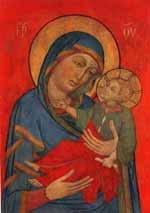
Menegelo Ivanov de Canali, Mother
of Christ with Child, Tryptych "Varoške Gospe", Permanent Exhibition of Sacral
Art in Zadar.
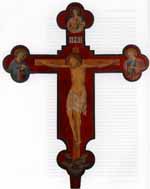
Menegelo Ivanov de Canali, Crucifix,
Ćokovac near Tkon on the isle of Pašman, SS Cosma and Damian's church.
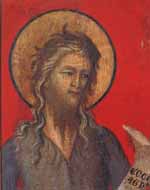
Menegelo Ivanov de Canali, Mother
of Christ with Child and St John the Baptist (detail).

Menegelo Ivanov de Canali (?),
Mother of Christ with Child, Matrikula Bratovštine 'Gospe od Umiljenja i Sv.
Ivana', Zadar, Scientific library.
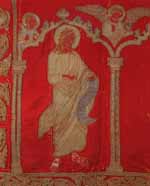
Menegelo Ivanov de Canali (?),
St John the Baptist, Zadar, Permanent Exhibition of Sacral Art.
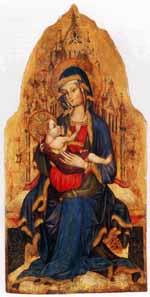
Ivan Petrov iz Milana, Mother
of Christ breast-feeding the Child, from St Mary's Monastery, Zadar, Permanent
Exhibition of Sacral Art.
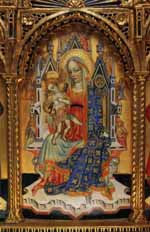
Ivan Petrov iz Milana, "Ugljan
Polyptych" (detail).

Ivan Petrov iz Milana, "Ugljan
Polyptych" (detail).

Ivan Petrov iz Milana, "Ugljan
Polyptych" (detail).
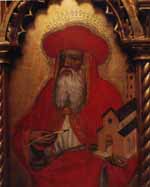
Ivan Petrov iz Milana, "Ugljan
Polyptych" (detail).
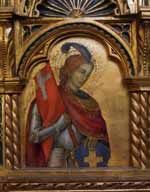
Ivan Petrov iz Milana, "Ugljan
Polyptych" (detail).
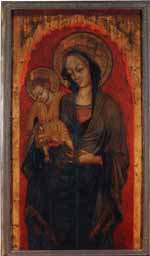
Dujam Vučković, Mother of Christ
with Child, Zadar, Franciscan monastery.
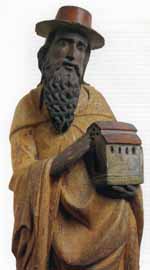
Petar de Riboldis and Dujam Marinov
Vučković, St Jerome, Zadar, Franciscan monastery.
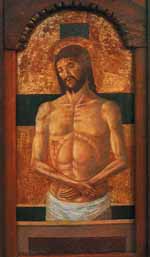
Circle of Francesco Squarcione,
Dead Christ (part of the former polyptych), Sali on Dugi otok, Parish church.
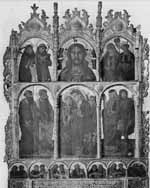
Petar Jordanić, Polyptych from
St Mary's church (lost in the Second World War).

Petar Jordanić, Fragment of the
painted ceiling of the Zadar cathedral, Zadar, Permanent Exhibition of Sacral
Art.

Catarino, Crucifix (detail), Zadar,
Permanent Exhibition of Sacral Art.
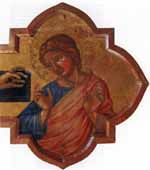
Catarino, Crucifix (detail), Zadar,
Permanent Exhibition of Sacral Art.
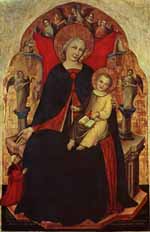
Nicolò di Pietro, "Madona
Belgarzone", Venice, Gallerie dell'Accademia.

"Bogorodica benediktinki" (detail),
Zadar, Permanent Exhibition of Sacral Art.
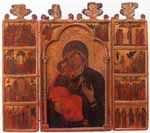
"Ugljan tryptych", Zadar, Permanent
Exhibition of Sacral Art.
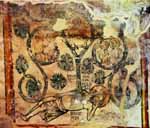
Jesse's tree, Zadar, Sacristy
of the Cathedral.
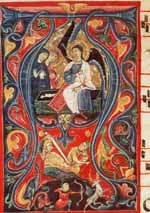
Illumination in the antiphonal,
Zadar, Franciscan monastery.
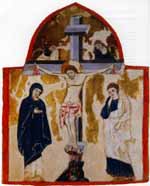
Crucifix, Zadar, Permanent Exhibition
of Sacral Art.
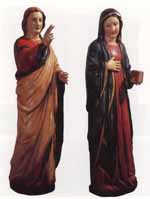
Annunciation Group, Zadar, Franciscan
monastery.




















































